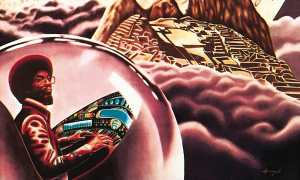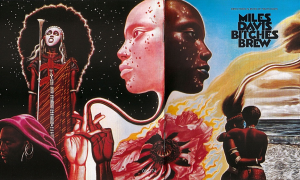Home » Jazz Articles » Rediscovery » A Sonic Compass: A Journey Through Prince's N·E·W·S
A Sonic Compass: A Journey Through Prince's N·E·W·S
With an enduring career spanning over five decades, the virtuoso mastered a plethora of instruments, perpetually exploring and trailblazing new creative horizons.
2003: The Year of Instrumental Releases
A curious pioneer of the early Internet era, Prince had a clear vision for how he wanted his fans to access his music. Thus, after the release of his twenty-third project, in 1999, Rave Un2 The Joy Fantastic, he sought innovative ways to promote his music online. In the following years, he founded his subscription service NPGOnline, where he published new music, exclusive releases, and official merch.Throughout that period, Prince was very active on the Internet and endeavored to establish a more robust connection with his fan base through his newly founded service, at pre-concert sound checks, and hosting yearly celebrations at Paisley Park music studios. Such events served Prince to connect with his fans as well as to strike up collaborations with fellow artists, including Norah Jones, Alicia Keys, Erykah Badu, and George Clinton .
Musically, 2003 was a particularly enticing year for Prince, who defied his audience's expectations, and released three instrumental, experimental albums: Xpectation , which came out in January, C-Note, and the avant-garde N·E·W·S in June.
At the end of May, the artist began to unveil clues concerning the release of N·E·W·S . Amidst the pointers, he displayed the album title on the floor of one of the rooms of his interactive website, the NPG Music Club.
Eventually, N·E·W·S followed the same strategy as the previous project, Xpectation. Initially, the songs were available solely online, and the first piece, "North," was disclosed on June 19th, 2003. In the ensuing days, "East," "West," and "South '' followed. However, contrary to Xpectation and C-Note, N·E·W·S was also available in physical edition; using a signing-up list, members of the NPG Club could order the CD.
The Early Stages of N·E·W·S
 During the early 2000s, Prince was eager to challenge himself artistically and venture into uncharted aural territories. The album N·E·W·S emerged as a transient divergence from his prior works, delving into the realm of the instrumental jazz genre.
During the early 2000s, Prince was eager to challenge himself artistically and venture into uncharted aural territories. The album N·E·W·S emerged as a transient divergence from his prior works, delving into the realm of the instrumental jazz genre. On February 6th, 2003, five musicians gathered at Prince's mansion, Paisley Park, for an informal musical collaboration. Although exiguous information has been provided, Prince's official website indicates that the ensemble recorded the album in a single day.
The project brandishes a stellar line-up of accomplished expert musicians, such as Rhonda Smith on acoustic and electric bass, drummer John Blackwell, Renato Neto on piano and synthesizer, Clare Fisher providing string samples on "North," and Eric Leeds, a former member of Prince's group, the Revolution as well as a core component of the jazz side project, Madhouse, on baritone and tenor saxophone. Prince predominantly performed on guitar, Fender Rhodes, digital keyboards, and percussion.
As a result, Prince's 27th project is a beguiling conceptual and sonic voyage, revealing the ensemble's musical dexterity. While the album does not follow a traditional narrative, its structure and themes delve deep into the significance of time and musical expression.
The album's title, N·E·W·S, is an acronym stemming from the initials of the cardinal directions—North, East, West, and South—representing the four musical compositions featured within the record. Such pieces and arrangements are akin to portraying diverse moments in time, space, emotional landscapes, and spirits, perhaps even different parts of the day. Indeed, each song provides a unique atmosphere, resulting in a comprehensive quest through various music genres, including jazz, funk, rock, and ambient music.
Interestingly, the album package and booklet include an image designed to resemble a compass opening up to four points, with the phrase "New Directions in Music," inscribed within it. The statement is a direct nod to trumpeter Miles Davis' albums from 1969 to 1973, which regularly displayed the dictum "Directions in Music." Moreover, including Eric Leeds as the lead saxophonist is particularly reminiscent of Prince's 1987 Madhouse, specifically albums #8 and #16, albeit the structure and feel of N.E.W.S are considerably distinct.
An In-depth Look at N·E·W·S
As multi-instrumentalist Renato Neto revealed, Prince expressed his interest in working on a jazz-fusion album. Thus, he gathered up with a small ensemble, including Rhonda Smith, John Blackwell, Renato Neto, and Eric Leeds, to collaborate on a musical session. Prince provided the directive that the album would comprise four themes titled "North," "East," "West," and "South," with each track clocking in at 14 minutes. As Neto recalled, the band began playing, and when they approached the fifteen-minute mark, they would conclude each session. At the end of the recording, Prince remained in the studio for some overdubs and, months later, presented the finished mix to the NPG. The result of the musical endeavors is one of Prince's most mysterious and suggestive projects. In the record, the artist played multiple instruments, showcasing his remarkable prowess and versatility.The album was a testament to Prince's philosophy of "let the music do the talking." Indeed, the music savant fashioned an exquisite, entirely instrumental work that oscillates between anxious and looming to delicate and rhythmic, recalling Sun Ra's experimentalism, Coltrane's improvisation, and Jimi Hendrix's mercurial guitar solos.
"North" opens the journey with a sultry and slow-paced tempo, setting the album's tone. The saxophone assumes the lead role, evoking the ambience of a jazz club. The drum work is exceptional, and Prince's guitar virtuosity shines through the subtle yet impactful solos. The enchanting, dusky atmosphere invites listeners to immerse themselves in the warm tones of Leed's saxophone, which holds the center stage in the first part of the piece. Rhonda Smith's mellow bass licks integrate and compensate seamlessly with John Blackwell's masterful, gentle beat work. Prince's howling guitar solo intertwines perfectly with the rest of the band, creating a rich tapestry of harmonies playing in call-response built around the central theme of the piece. Renato Neto's elegant piano and Leeds' final saxophone chords conclude the performance, as the nocturnal refrain vanishes in thirty seconds of nature-hued sounds.
Musically savvy to his very core, Prince would usually incorporate different elements and scales, unveiling his exploratory style. His inclination towards Middle Eastern traditions was unmistakable, as he frequently merged aspects from the genre. Notable examples include songs like "Thunder," "The Continental," and "The Greatest Romance Ever Sold" which feature prominent Arabic musical components. As the title suggests, the album's second piece, "East," is aligned with such harmonic spectrums. In contrast with the lulling "North," "East" begins with a sonically expansive section that gradually builds the suspense before transitioning into a groovier, upbeat passage. Prince's punchy guitar melds flawlessly with Smith's rapid bass plunks, culminating in a vibrant improvisation. The layered, complex rhythmic pattern adds depth and dimension to the piece.
Finally, "East" returned to its central theme to softly segue to the next suite, "West." Like the preceding tracks, "West" presents the same structure: Prince delicately strumming the guitar, slowly developing into an ethereal melody—perhaps foreshadowing the then-forthcoming song "Call My Name"—emblazoned by sensual, syncopated bass-line and saxophone rich tones. The suite comprises two distinct parts; the second section unlocks as a funk jam, providing pianist Renato Neto with the space to reveal a glorious set of bossa nova-tinged lilts. The pulsating grooves pinnacle into a magnificent march-like pomp rock reminiscent of Prince's "3 Chains 'O' Gold" enriched by a lengthy guitar solo supported by Neto's piano modal passage. Overall, "West" breaks away from traditional jazz, providing a collection of soundscapes that transport the listener to an idyllic state.
As an avid fan of funk, Prince incorporated the genre into the album, with driving bass and drums serving as the foundation of the first cut of the following song. "South" unfolds on a spirited note; however, the latter half presents a more relaxed beat, highlighting the band's diverse range of musical styles. Subsequently, the theme unwinds into a classic jazz piece, fashioning an array of rhythms, melodies, techniques, and textures, with Leeds and Neto leading the performance, accompanied by Prince's nuanced guitar work. Concluding with a few sparse piano chords, the song provides a moment of reflection to revel in the last seconds of the immersive, suggestive musical journey.
Following N·E·W·S, Prince revisited his signature sound with the twenty-eight release, Musicology. Originally conceived as a collaborative improvisational project, N.E.W.S presents the artist's ephemeral departure from his previous works. The album is a bewitching masterwork, a testament to Prince's and the NPG's virtuosity as musicians. The record takes the listener on an aural journey through various moments in time and space, offering a unique experience that encompass diverse music genres. Ultimately, N·E·W·S serves as an invitation to wander into uncharted musical territories, all while commemorating Prince's innovative spirit and zeal to explore new musical horizons.
< Previous
The Most Exciting Jazz Albums Since 1...
Next >
Grit & Grace
Comments
Tags
For the Love of Jazz
 All About Jazz has been a pillar of jazz since 1995, championing it as an art form and, more importantly, supporting the musicians who create it. Our enduring commitment has made "AAJ" one of the most culturally important websites of its kind, read by hundreds of thousands of fans, musicians and industry figures every month.
All About Jazz has been a pillar of jazz since 1995, championing it as an art form and, more importantly, supporting the musicians who create it. Our enduring commitment has made "AAJ" one of the most culturally important websites of its kind, read by hundreds of thousands of fans, musicians and industry figures every month.























